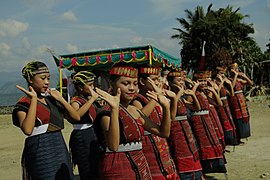Tortor
Tortor dance is a traditional Batak ancient type dance originating from North Sumatra, Indonesia. Tortor is a ceremonial dance that is presented with gondang music. Physically, tortor is a dance, but the meaning that is more than just its movements shows that tortor is a communication medium, where through the movements that are presented, there is interaction between the ceremonial participants.[1]
 Tortor performance | |
| Native name | Tari Tortor |
|---|---|
| Origin | Indonesia |
Before the event was conducted, openly, first the host (Hasuhutan) conducted a special event called Tua ni Gondang. In the performance of the dance, one of the members of the hasuhutan (who has the program will request a request from the gondang musician with polite word. Each finished one request is always interspersed with a gondang punch with a certain rhythm in a few moments. After the request / appeal was carried out properly, the ranks of the family of suhut who were ready to manortor (dancing) arranged the arrangement of their places to start dancing.
The types of requests for the types of songs that will be sounded are as follows: Requests to Gods and ancestral spirits so that the family of the suhut who conducts the event are given abundant safety, happiness, and sustenance, and the traditional ceremonies to be performed are a source of blessing for the suhut and the whole family, as well as the invitees.
Every tortor dancer must use ulos and use a musical instrument / gondang (Uninguningan).
There are many restrictions that are not allowed when the manortor, such as the dancer's hand may not cross the line at shoulder height up, if it is done means the dancer is ready to challenge anyone in the field of shamanism, or fighting pencak silat (moncak), or an inner power struggle and others.
Tortor dance is used as a means of conveying the mind both to ancestral spirits and to people who are respected (guests) and delivered in the form of dance showing respect.[2][3]
See also
- Sigale gale
- Dance of Indonesia
References
- "5 Fakta Menarik Tari Tor Seni Traditional Kebanggaan orang Sumatra Utara". Merdeka.com (in Indonesian). Retrieved 2020-07-06.
- "Asal Kisah Tarian Tortor dan Patung Sigale gale". Detik.com (in Indonesian). Retrieved 2020-07-07.
- "Tortor Batak Bukan Hiburan". kompas.com (in Indonesian). Retrieved 2020-07-08.
